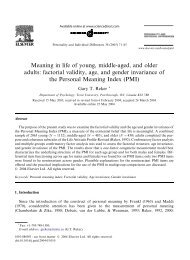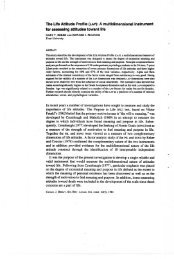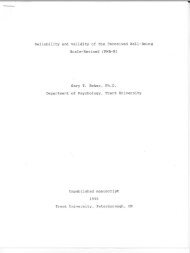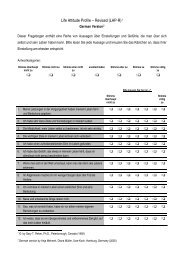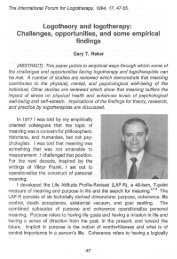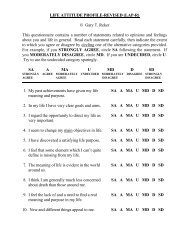Get PDF (68K) - Wiley Online Library
Get PDF (68K) - Wiley Online Library
Get PDF (68K) - Wiley Online Library
You also want an ePaper? Increase the reach of your titles
YUMPU automatically turns print PDFs into web optimized ePapers that Google loves.
B. Erci<br />
dimensions ranged between 0Æ72–0Æ87 and 0Æ80–0Æ92 for the<br />
composite scales.<br />
Healthcare researchers who work with culturally diverse<br />
communities need to be aware that the measurement of<br />
meaning of life may vary in different cultural groups.<br />
Therefore, the LAP-R may be the best representation of the<br />
constructs of meaning in life from a Turkish perspective, and<br />
thus may be culturally sensitive. Because these commonly<br />
described Turkish cultural values may influence the measurement<br />
of meaning in life, this study was conducted to<br />
determine whether the scale structure of the LAP-R in its<br />
present form taps into these culturally salient values, and thus<br />
whether it is appropriate for use with Turkish patients with<br />
cancer.<br />
The study<br />
Aim<br />
The aim of the study was to adapt the LAP-R Scale for<br />
Turkish patients with cancer and to evaluate its psychometric<br />
properties.<br />
Design<br />
The phases of the study were: (1) translation into the Turkish<br />
language from the English version and back-translation into<br />
English; (2) content analysis by a panel of specialists; and (3)<br />
pre-test and psychometric testing (factor analysis, a reliability<br />
coefficient and inter-item correlations). The data were<br />
collected in 2006.<br />
Participants<br />
The participants were 199 patients with cancer at a university<br />
hospital medical oncology department in Turkey. The<br />
patients were selected through convenience sampling. The<br />
eligibility criteria were: (1) being registered with a primary<br />
diagnosis of cancer in the oncology clinic; (2) aged 18 years<br />
or more, (3) able to read and understand the Turkish<br />
language and (4) no history of psychiatric illness.<br />
Translation procedures<br />
In the first instance, the LAP-R Scale was translated into<br />
Turkish. The Turkish version was then translated into<br />
English by two Turkish lecturers, who worked<br />
independently on the translation. The lecturers both<br />
worked as professors who teach English language at the<br />
Atatürk University. The two translated versions were<br />
compared by the author and analysed until there was a<br />
consensus about the initial translation. Their initial translation<br />
into Turkish was back-translated into English. The<br />
translation phase had the purpose of checking for discrepancies<br />
between the content and meaning of the original<br />
version and the translated instrument. All of the versions<br />
were evaluated by the author and a final version was<br />
formed.<br />
Content validity<br />
To test item clarity and content validity, the translated<br />
version was submitted to a panel of seven specialists. They<br />
were informed about the measures and concepts involved by<br />
the author. This multidisciplinary panel comprised two<br />
public health specialists, two experts who had published<br />
papers on cancer and three nurses who had conducted<br />
research in the oncology. Each of the panel members was<br />
asked to evaluate the content of the final translated version of<br />
the LAP-R Scale compared to the original instrument. The<br />
experts were asked to evaluate each item at the scale using a<br />
7-point Likert Scale: 7 = strongly agree, 6 = agree, 5 = moderately<br />
agree, 4 = undecided, 3 = moderately disagree,<br />
2 = disagree, 1 = strongly disagree.<br />
Pre-test<br />
The final version of the translated instrument was pre-tested<br />
with a pilot group of 30 patients from the medical oncology<br />
clinics. The pre-test was conducted at the outpatient and<br />
inpatient medical oncology clinics where the main study was<br />
to be carried out. To simplify the recording of doubts and<br />
suggestions about the scale, a questionnaire was used,<br />
requesting general information from the interviewee, such<br />
as gender, age, civil status and occupation. An open-ended<br />
question to record doubts and suggestions was provided for<br />
each of the items.<br />
Data collection<br />
The researcher visited the oncology clinic on five working<br />
days in every week and conducted interviews with the<br />
patients. The questionnaire was explained to the participants,<br />
who then read it and marked their answers on the<br />
sheets. The questionnaire took approximately 20 minutes to<br />
complete and could be understood by people with minimal<br />
reading ability. It was given to patients in a separate quiet<br />
room in the oncology clinic. All participants completed the<br />
questionnaire. Test–retest of the scale was conducted after<br />
4 weeks.<br />
706 Ó 2008 The Author. Journal compilation Ó 2008 Blackwell Publishing Ltd



